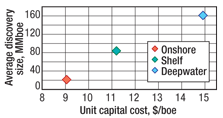DEEPWATER
STATISTICAL REPORT
How deepwater exploration fits into the big picture
BP’s recent giant Tiber discovery in the Gulf of Mexico Palaeogene play illustrates the potential of deepwater exploration to deliver large new discoveries, as well as the excitement that they can generate. With heightened interest in deep water following the Tiber discovery, and a series of giant discoveries in the pre-salt play in Brazil, we ask: how does deep water compare to onshore and shelf areas in terms of exploration success?
An examination of global exploration between 1999 and 2008 across onshore, shelf and deep water (water depths greater than 400 m), reveals that deep water has had the greatest impact in exploration in this period.
Exploration has added over 200 Bboe of resource in new fields in the last decade. This has been spread across the onshore, shelf and deepwater areas, but nearly half of all giant discoveries have been made in deep water and, in 2007 and 2008, deepwater plays delivered more than half of the total volumes discovered.
Deepwater exploration also stands out in investment terms. Over the last decade, deep water has attracted nearly 40% of exploration investment. While this investment has been justified by the volumes added, the question remains as to whether the expense of exploring in deep water erodes the value that can be realized from exploration. The answer to this question appears to be “no”—as long as oil remains at or above current prices.
The large upfront expense of deepwater exploration means that this is a much higher risk investment than onshore or shelf exploration, and while success rates are lower in onshore plays, there is little difference in success rates between shelf and deepwater plays.
However, the true bounty of the deep water is seen in the size of the average deepwater discovery—which is nearly double that in shelf areas, and four times the average onshore discovery size. In fact, since 2006, the average deepwater discovery has been five times the size of the average find in shelf areas, and 10 times the average onshore discovery.
Development costs are also higher in deep water, and while these are mitigated by lower taxes in a $70/bbl environment, if prices are lower, high development costs mean that much of the discovered deepwater resource will be not be developed and will fail to add value. In a $40/bbl environment, deepwater exploration is much less attractive than either shelf or onshore exploration. Explorers are naturally drawn to frontier areas with the largest prospects. Those who believe oil prices will remain at current levels have the opportunity to generate superior returns in the deep water. 
|



